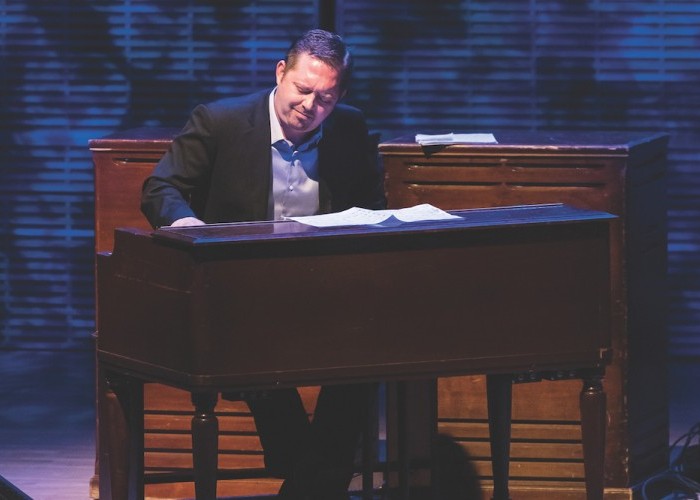Apr 2, 2024 12:59 PM
Saxophonist, Sonic Explorer Casey Benjamin Dies at 45
Casey Benjamin, the alto saxophonist, vocalist, keyboardist and producer who stamped his distinctive sounds on the…

On his new album, In The Moment, organist Pat Bianchi collaborates with numerous jazz heavyweights, including guitarist Pat Martino and vibraphonist Joe Locke.
(Photo: Jack Vartoogian/Front Row Photos)At age 16, Pat Bianchi received a prized Christmas present: organist Joey DeFrancesco’s 1993 album Live At The Five Spot. He was so taken with the music that, after one listen, he saw his future mapped out before him.
A quarter-century later, Bianchi has achieved that goal—emulating DeFrancesco, now a mentor and colleague, even as he carves out a spot for himself among jazz’s elite organists.
The latest evidence is In The Moment (Savant), a 10-track collection that shows the range of Bianchi’s impressive capabilities.
“He’s got soulfulness, swing and an ability to adapt to what’s going on with fluency,” said Byron Landham, who played drums on both Bianchi’s new album and DeFrancesco’s Live At The Five Spot.
Those qualities come through clearly as Bianchi teams with three guitarists on his latest recording. He interacts closely with Peter Bernstein on a seven-minute rendition of “Blue Gardenia,” establishing a flow that never wavers. The flow similarly is apparent on the Bianchi original “Mr. PM,” though the organist, by his own account, is more intent on building a structure on which the venerable guitarist Pat Martino—with whom he has a seven-year association as both sideman and tour manager—can deliver his lean, clean lines with characteristic precision.
The four tracks with guitarist Paul Bollenback, who also was on Live At The Five Spot, find Bianchi in full creative flight as he rips through a warp-speed rendition of Willie Nelson’s “Crazy” and dips in and out of a modal swim for Bollenback’s slightly trippy take on Miles Davis and Gil Evans’ “Barracudas (General Assembly).”
Bianchi dives into digitization on Billy Eckstine’s elegant “I Want To Talk About You,” creating a synthesized string quartet to back the vocals of Kevin Mahogany (1958–2017). Blended with Bianchi’s organ fills and Landham’s brushwork—both models of restraint—the “strings” provide a lush bed for Mahogany’s resonant baritone.
The sonic variants don’t end there. Bianchi joins with drummer Carmen Intorre Jr., with whom he has a long relationship, and vibraphonist Joe Locke, with whom he had never previously played, on three jazz standards: Chick Corea’s “Humpty Dumpty,” Thelonious Monk’s “Four In One” and Wayne Shorter’s “Fall.”
Loose and sonorous, the trio’s interpretation of “Fall”—which harks back to Davis’ 1968 album Nefertiti—offers a window into regions Bianchi might continue to explore.
Winner of the Rising Star–Organ category in DownBeat’s 2016 Critics Poll, Bianchi has spent long hours alone at the organ developing his command of the instrument.
Nowadays, he has a well-earned reputation as a bandleader and educator. Bianchi teaches jazz organ at Temple University’s Boyer College of Music and Dance. Earlier in his career, he performed with DeFrancesco, saxophonist Lou Donaldson and guitarist Chuck Loeb.
Bianchi has taken detours in the past—notably in 2011, when he turned left into the world of organist Larry Young (1940–’78), who in 1966 won the DownBeat Critics Poll award equivalent to the one Bianchi won 50 years later. The vehicle was drummer Ralph Peterson’s Unity Project, which tackled such riotous compositions as John McLaughlin’s “Spectrum.” Young had played the piece in the power-trio version of Tony Williams’ Lifetime, with McLaughlin on guitar. That project provided a platform for some of Bianchi’s most virtuosic turns.
The bandleader’s deep knowledge of jazz-organ history continues to inform his own voice as a composer and accompanist. And while he’s a proponent of the classic jazz organ trio sound, he’s not confined by it.
“My go-to in the beginning was Joey, then I went back to [Jimmy] Smith,” Bianchi recalled. “I love [Jimmy] McGriff. I checked out Young’s harmonic concept, but I didn’t get the same feeling.” DB

Benjamin possessed a fluid, round sound on the alto saxophone, and he was often most recognizable by the layers of electronic effects that he put onto the instrument.
Apr 2, 2024 12:59 PM
Casey Benjamin, the alto saxophonist, vocalist, keyboardist and producer who stamped his distinctive sounds on the…

“He’s constructing intelligent musical sentences that connect seamlessly, which is the most important part of linear playing,” Charles McPherson said of alto saxophonist Sonny Red.
Feb 27, 2024 1:40 PM
“I might not have felt this way 30 to 40 years ago, but I’ve reached a point where I can hear value in what people…

Albert “Tootie” Heath (1935–2024) followed in the tradition of drummer Kenny Clarke, his idol.
Apr 5, 2024 10:28 AM
Albert “Tootie” Heath, a drummer of impeccable taste and time who was the youngest of three jazz-legend brothers…

“Both of us are quite grounded in the craft, the tradition and the harmonic sense,” Rosenwinkel said of his experience playing with Allen. “Yet I felt we shared something mystical as well.”
Mar 12, 2024 11:42 AM
“There are a few musicians you hear where, as somebody once said, the molecules in the room change. Geri was one of…

Henry Threadgill performs with Zooid at Big Ears in Knoxville, Tennessee.
Apr 9, 2024 11:30 AM
Big Ears, the annual four-day music celebration that first took place in 2009 in Knoxville, Tennessee, could well be…